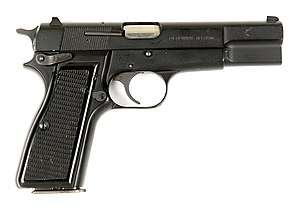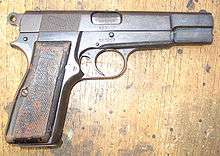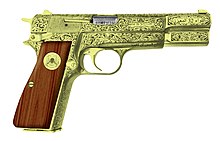Browning Hi-Power
The Browning Hi-Power is a single-action, semi-automatic handgun available in the 9mm and .40 S&W calibers. It was based on a design by American firearms inventor John Browning, and completed by Dieudonné Saive at Fabrique Nationale (FN) of Herstal, Belgium. Browning died in 1926, several years before the design was finalized. The Hi-Power is one of the most widely used military pistols in history,[6] having been used by the armed forces of over 50 countries.[1] After 82 years of continuous production, the Hi-Power was discontinued in 2017 by Browning Arms, but it remained in production in some countries, under license.[7]
| Browning Hi-Power | |
|---|---|
 Fabrique Nationale Browning Hi-Power | |
| Type | Semi-automatic pistol |
| Place of origin |
|
| Service history | |
| In service | 1935–present[1] |
| Used by | See Users |
| Wars |
|
| Production history | |
| Designer | |
| Designed | 1914–1935[1] |
| Manufacturer |
|
| Produced | 1935–2017[1] |
| No. built | 1,500,000+[5] |
| Variants | See Variants |
| Specifications | |
| Mass | 1 kg (2.2 lb)[1] |
| Length | 197 mm (7.8 in)[1] |
| Barrel length | 119 mm (4.7 in)[1] |
| Cartridge | |
| Action | Short recoil operated tilting barrel |
| Rate of fire | Semi-automatic |
| Muzzle velocity | 335 m/s (1,100 ft/s) (9mm)[1] |
| Effective firing range | 50 m (54.7 yd) |
| Feed system | Detachable box magazine; capacities:
|
The Hi Power name alludes to the 13-round magazine capacity, almost twice that of contemporary designs such as the Luger or Colt M1911. The pistol is often referred to as an HP (for "Hi-Power" or "High-Power"),[8] GP (for the French term, "Grande Puissance"), BAP (Browning Automatic Pistol), or BHP (Browning High-Power). The terms P-35 and HP-35 are also used, based on the introduction of the pistol in 1935.
Several sources indicate that the official name was initially "High Power", while it was manufactured in Belgium by Fabrique Nationale prior to the German occupation in World War II. Production of the weapon then moved to a John Inglis and Company plant in Canada; at some date afterwards, the name was changed to "Hi Power". (Some sources indicate that the name change was not until the 1950s.) Production returned to Belgium after the war, in 1944 or 1945.[9][10] Nonetheless, the term Hi Power has been the most commonly used in articles over the past decades, regardless of the year of manufacture. Versions of the handgun continued to be made at the FN factory in Belgium under Wehrmacht control, with the designation "9mm Pistole 640(b)".[11][12][13]
In February 2018, FN Herstal announced that the Hi-Power will end production.[14]
Development

The Browning Hi-Power was designed in response to a French military requirement for a new service pistol, the Grand Rendement (French for "high yield"), or alternatively Grande Puissance (literally "high power"). The French military required that:
- the arm must be compact
- the magazine have a capacity of at least 10 rounds
- the gun have a magazine disconnect device, an external hammer, and a positive safety
- the gun be robust and simple to disassemble and reassemble
- the gun be capable of killing a man at 50 metres
This last criterion was seen to demand a caliber of 9 mm or larger, a bullet mass of around 8 grams (123.5 grains), and a muzzle velocity of 350 m/s (1148 ft/s). It was to accomplish all of this at a weight not exceeding 1 kg (2.2 lb).
FN commissioned John Browning to design a new military sidearm conforming to this specification. Browning had previously sold the rights to his successful M1911 U.S. Army automatic pistol to Colt's Patent Firearms, and was therefore forced to design an entirely new pistol while working around the M1911 patents. Browning built two different prototypes for the project in Utah and filed the patent for this pistol in the United States on 28 June 1923, granted on 22 February 1927.[15][16] One was a simple blowback design, while the other was operated with a locked-breech recoil system. Both prototypes utilised the new staggered magazine design (by designer Dieudonné Saive) to increase capacity without unduly increasing the pistol's grip size or magazine length.
The locked breech design was selected for further development and testing. This model was striker-fired, and featured a double-column magazine that held 16 rounds. The design was refined through several trials held by the Versailles Trial Commission.
In 1928, when the patents for the Colt Model 1911 had expired, Dieudonné Saive integrated many of the Colt's previously patented features into the Grand Rendement design, in the Saive-Browning Model of 1928. This version featured the removable barrel bushing and take down sequence of the Colt 1911.
By 1931, the Browning Hi-Power design incorporated a shortened 13-round magazine, a curved rear grip strap, and a barrel bushing that was integral to the slide assembly. By 1934, the Hi-Power design was complete and ready to be produced. It was first adopted by Belgium for military service in 1935 as the Browning P-35. Ultimately, France decided not to adopt the pistol, instead selecting the conceptually similar but lower-capacity Modèle 1935 pistol.
Design
The Browning Hi-Power has undergone continuous refinement by FN since its introduction. The pistols were originally made in two models: an "Ordinary Model" with fixed sights and an "Adjustable Rear Sight Model" with a tangent-type rear sight and a slotted grip for attaching a wooden shoulder stock. The adjustable sights are still available on commercial versions of the Hi-Power, although the shoulder stock mounts were discontinued during World War II. In 1962, the design was modified to replace the internal extractor with an external extractor, improving reliability.
Standard Hi-Powers are based on a single-action design. Unlike modern double-action semi-automatic pistols, the Hi-Power's trigger is not connected to the hammer. If a double-action pistol is carried with the hammer down with a round in the chamber and a loaded magazine installed, the shooter may fire the pistol either by simply squeezing the trigger or by pulling the hammer back to the cocked position and then squeezing the trigger. In contrast, a single-action pistol can only be fired with the hammer in the cocked position; this is generally done when a loaded magazine is inserted and the slide cycled by hand. In common with the M1911, the Hi-Power is therefore typically carried with the hammer cocked, a round in the chamber and the safety catch on (a carry mode often called cocked and locked in the United States or "made ready" in the UK, or sometimes called condition one).
The Hi-Power, like many other Browning designs, operates on the short-recoil principle, where the barrel and slide initially recoil together until the barrel is unlocked from the slide by a cam arrangement. Unlike Browning's earlier Colt M1911 pistol, the barrel is not moved vertically by a toggling link, but instead by a hardened bar which crosses the frame under the barrel and contacts a slot under the chamber, at the rearmost part of the barrel. The barrel and slide recoil together for a short distance but, as the slot engages the bar, the chamber and the rear of the barrel are drawn downward and stopped. The downward movement of the barrel disengages it from the slide, which continues rearward, extracting the spent case from the chamber and ejecting it while also re-cocking the hammer. After the slide reaches the limit of its travel, the recoil spring brings it forward again, stripping a new round from the magazine and pushing it into the chamber. This also pushes the chamber and barrel forward. The cam slot and bar move the chamber upward and the locking lugs on the barrel re-engage those in the slide.
Design flaws
The pistol has a tendency to "bite" the web of the shooter's hand, between the thumb and forefinger. This bite is caused by pressure from the hammer spur, or alternatively, by pinching between the hammer shank and grip tang. This problem can be fixed by altering or replacing the hammer, or by learning to hold the pistol to avoid injury. While a common complaint with the commercial models with spur hammers similar to that of the Colt "Government Model" automatic, it is seldom a problem with the military models, which have a smaller, rounded "burr" hammer, more like that of the Colt "Commander" compact version of the 1911. Another flaw is that the original small safety is very hard to release and re-engage. This is because when cocked, the shaft the safety turns on is under hammer spring pressure. Later versions went to a larger safety to address this issue.[17][18][19][20]
Military service
Browning Hi-Power pistols were used during World War II by both Allied and Axis forces. After occupying Belgium in 1940, German forces took over the FN plant. German troops subsequently used the Hi-Power, having assigned it the designation Pistole 640(b) ("b" for belgisch, "Belgian").[6] Examples produced by FN in Belgium under German occupation bear German inspection and acceptance marks, or Waffenamts, such as WaA613. In German service, it was used mainly by Waffen-SS and Fallschirmjäger personnel.

High-Power pistols were also produced in Canada for Allied use, by John Inglis and Company in Toronto. The plans were sent from the FN factory to the UK when it became clear the Belgian plant would fall into German hands, enabling the Inglis factory to be tooled up for Hi-Power production for Allied use. Inglis produced two versions of the Hi-Power, one with an adjustable rear sight and detachable shoulder stock (primarily for a Nationalist Chinese contract) and one with a fixed rear sight. Production began in late 1944 and they were on issue by the March 1945 Operation Varsity airborne crossing of the Rhine into Germany. The pistol was popular with the British airborne forces as well as covert operations and commando groups such as the Special Operations Executive (SOE), the U.S. Office of Strategic Services (OSS) and the British Special Air Service (SAS) Regiment. Inglis High-Powers made for Commonwealth forces have the British designation 'Mk 1', or 'Mk 1*' and the manufacturer's details on the left of the slide. They were known in British and Commonwealth service as the 'Pistol No 2 Mk 1', or 'Pistol No 2 Mk 1*' where applicable. Serial numbers were 6 characters, the second being the letter 'T', e.g. 1T2345. Serial numbers on pistols for the Chinese contract instead used the letters 'CH', but otherwise followed the same format. When the Chinese contract was cancelled, all undelivered Chinese-style pistols were accepted by the Canadian military with designations of 'Pistol No 1 Mk 1' and 'Pistol No 1 Mk 1*'.[21]
In the postwar period, Hi-Power production continued at the FN factory and, as part of FN's product range which included the FN FAL rifle and FN MAG general-purpose machine gun. It has been adopted as the standard service pistol by over 50 armies in 93 countries. At one time most NATO nations used it, and it was standard issue to forces throughout the British Commonwealth. It was manufactured under licence, or in some cases cloned, on several continents. Former Iraqi ruler Saddam Hussein often carried a Browning Hi-Power. Former Libyan ruler Muammar Gaddafi carried a gold-plated Hi-Power with his own face design on the left side of the grip which was waved around in the air by Libyan rebels after his death.[22] A Hi-Power was used by Mehmet Ali Agca during the assassination attempt of Pope John Paul II in 1981.
While the Hi-Power remains an excellent design, since the early 1990s it has been eclipsed somewhat by more modern designs which are often double-action and are manufactured using more modern methods. It remains in service throughout the world. As of 2017, the MK1 version remained the standard service pistol of the Canadian Armed Forces, with the SIG Sauer P226 being issued to specialised units along with the SIG Sauer P225. The weapon is the standard sidearm of the Belgian Army, Indian Army, Indonesian Armed Forces, Australian Defence Force, Argentine Army, Luxembourg Army, Israel Police, and Venezuelan Army, among others. The Irish Army replaced its Browning Pistols (known popularly as BAPs, or Browning Automatic Pistols) with the Heckler & Koch USP in 2007. From 2013 the British Army is replacing the Browning with the polymer-framed Glock 17 Gen 4 pistol, due to concerns about weight and the external safety of the pistol.[23]
In 2017, FN ended production of the Hi-Power.[24] The Hi-Power is still being produced under license by the Ishapore Rifle Factory in India, and unlicensed copies are still being built in other countries like Hungary and Turkey.[25]
Specifications of the Mk I
A locked-breech, semi-automatic, single-action, recoil-operated pistol. The Browning Hi-Power Mk I uses a 13-round staggered magazine.
- Caliber: 9 mm
- Length: 197 mm
- Barrel length: 118 mm
- length of rifled part: 100 mm
- number of grooves: 6
- direction of twist: right
- Height (without sight, loaded): 127.5 mm
- Width (with stocks): 36 mm
- (without stocks): 25.5 mm
- Weight (with empty magazine): 0.9 kg
- (with loaded magazine): 1.060 kg
- Capacity of magazine: 13 cartridges
- Modes of fire: Single action
- Muzzle velocity: 350 m/s
- V12.50: 340 m/s
- Muzzle energy: 500 J
- Safeties: Half-cock notch, manual thumb safety, firing pin block, and magazine disconnect
- Trigger pull: 7.5 lb
- Effective Range: 50 m
- Dispersion (firing 10 shots with rest)
- at 15 metres: 95 mm (height 50 mm, width 45 mm)
- at 30 metres: 200 mm (height 105 mm, width 95 mm)
- at 50 metres: 320 mm (height 170 mm, width 150 mm)
Variants
Genuine Browning Hi-Power P-35s are still manufactured by FN Herstal of Belgium and Portugal and under licence by Fabricaciones Militares (FM) of Argentina. The Hi-Power remains one of the most influential pistols in the history of small arms. It has inspired a number of clone manufacturers (including Charles Daly of the Philippines & the US, FEG of Hungary, Arcus of Bulgaria, IMI of Israel, and others). Many modern pistols borrow features from it, such as the staggered column high-capacity magazine, and the Browning linkless cam locking system (which on modern pistols is often simplified so that the barrel locks into the ejection port, meaning the barrel and slide do not have to be machined for locking lugs). Until recently, FEG made an almost exact clone in 9mm and .40 S&W, but the company now manufactures a version with modifications to the barrel, linkage, and slide stop that are incompatible with genuine Hi-Powers. Arcus has also superseded its Arcus 94 Hi-Power clone with the Arcus 98DA, a model that draws heavily from the Hi-Power but is capable of double-action operation.
- The original P35, as noted earlier, featured an internal extractor. During World War II, it was manufactured by Inglis of Canada for Allied use, and by FN in occupied Belgium for German use. The P35s made under Nazi occupation were designated as the Pistole 640b. Most Canadian P35s were manufactured with a parkerized finish, while most P35s manufactured in occupied Belgium had a blued finish. In 1962 the internal extractor was replaced with a more durable and reliable external extractor alongside other modifications, including a 2-piece barrel and modifications to the locking system for improved durability. Later barrels and frames are not interchangeable with earlier ones.
- The L9A1, was the British designation for the military version of the post-1962 Hi-Power, and is marked 'Pistol Automatic L9A1' on the left side of the slide. It started to replace Inglis variants in British service from the late 1960s, and the two types remained in service together until the Inglis variants were finally retired in the late 1980s. It is still in service with the UK military forces, although now fitted with the more ergonomic Mk2 ambidextrous safety and grips. The L9A1 was also widely used by other Commonwealth armed forces. The Hi-Power was the pistol issued to the British Special Air Service throughout the Cold War era. It was phased out in 2013 and replaced with the Glock 17.[26]
- The Mark I is among the best-known models of the P35 developed over the last 50 years. P35s were first imported into the US in 1954 – the US civilian market P35s had the 'Browning Arms Company' stamp on the left side of the slide (to meet the import requirement for US sales under ATF Section 478.112). These P35s lack the provision of the lanyard ring – the left side pistol grip for a Mark I is fully covered unlike those produced for military and law enforcement use. A wide variety of options and features are available on the P35 models. Recently, Hi-Power pistols have become available in the .40 S&W and .357 SIG loadings. The use of these calibres in guns designed and built for 9×19mm Parabellum has created cases of broken or warped frames. Only Hi-Powers specifically built for these rounds should be used to fire them. The pistols manufactured for these two rounds are easily identified by examining the left side of the slide – a groove is machined into the side of the heavier slide to allow clearance for the slide release. Genuine FN-produced P35s (either FN (Europe/international) or Browning (USA) for the civilian market will have a 245-prefix serial number. Some Hi-Power variants (Type 65, Type 73) incorporate production changes e.g. spur hammers (commonly seen for 1971–present civilian market P35s) and/or 2-piece barrels (1965–present). The 'Type 73' variant (with an elongated barrel bushing) of the Mark I was produced into the late 1980s (to 1987) by FM Argentina when Mark II production commenced in the early-mid-1980s (Belgium).
- The Pistol, Browning FN 9mm, HP No. 2 MK.1/1 Canadian Lightweight Pattern was a series of experimental aluminum/aluminum alloy framed Browning Hi-Power pistols by the Canadian Inglis Company that reduced the weight by as much as 25% (8.5 oz lighter to 25.5 oz).[27] Two scalloped cuts were made on both sides of the steel slide as well as in front of the rear sight. The reception to this was positive and so six prototype frames were machined from solid aluminum and two send to each of the Canadian, American, and British governments for testing. The Canadian and English governments concluded that sand and dirt caught between the steel slide and aluminum frame substantially increased wear. The steel locking block also wore the holes in its aluminum frame. After testing Inglis cast 29 frames and assembled 21 pistols and tested them which was met with various problems. The lightweight program was ended in Canada in 1951. In 1952, a US Major General Kessels requested one and took it with him in the Korean War.[28]
- The Mark I Lightweight is a very rare variant of the Mark I made with a lightweight alloy frame originally intended for paratroop use. According to Massad Ayoob, these were introduced commercially in the 1950s but never caught on. The Lightweights are marked only with Fabrique Nationale's rollmarks, not Browning's.
- Mark II is an upgraded model of the original Hi-Power introduced in the early '80s. Some of the upgrades were ambidextrous thumb safeties, nylon grips, 3-dot sights, and a throated barrel.
- Mark III was another advancement over the Mark II released in 1988, which featured a firing pin safety and a black epoxy finish. The main distinguishing (visual) feature of the Mark III is the absence of the water drain hole below the muzzle on the forward face of the slide.
- Standard is the name given to the Mark III variant with walnut grips, gloss finish, and choice of sights. A Standard is a Mark III model, but a Mark III is not necessarily a Standard.
- The Silver Chrome featured a silver-chrome frame and slide, and Pachmayr rubber grips. The magazines for the silver chrome BHP had a dull finish and a black rubber Pachmayr basepad.
- The Capitan is a Mark III variant that features adjustable tangent rear sights and a "ring hammer" like the early model HP35, checkered walnut grips, and a blued finish. It was reintroduced in 1993 and is still in production (c.2004).[29]
- The Practical is a Mark III variant that features a matte-blued slide and contrasting silver-chromed frame. In addition, this model has wraparound Pachmayr rubber grips and a "ring hammer". The Practical has fixed or adjustable sights, and is available in either 9 mm or .40 S&W. Magazines for all Practical models sport Pachmayr base pads; magazines feature a cartridge capacity of 13 rounds in 9 mm and a cartridge capacity of 10 rounds in .40 S&W.[30]

- The HP-SFS (Safe-Fast-Shooting) is a current variation on the Hi-Power Mark III with a modified firing mechanism. After the weapon is loaded, the hammer is pushed forward, which automatically activates the safety catch. When the shooter is prepared to fire, the safety is pressed down with the thumb, releasing the hammer to spring backwards into the usual, single-action position. A similar system is available for modifying Colt M1911A1s. Magazines are interchangeable with the Mark III and others.
- The BDA and BDAO models were first produced in the 1980s by FN. The BDA model is double-action, and the BDAO model is "double-action only," both versions differing from the usual single-action operation of the P35. These designs have also been marketed as the FN HP-DA and Browning BDA. The DA and DAO models retain many features of the P35, and both are available in full-sized and compact versions. The performance of these models is consistent with FN's high standards. These models resemble the P35, but the most distinguishing feature is the extended SIG-Sauer style trigger guard. Many parts are interchangeable with the P35, but the magazines (although similar) are not. The compact versions also utilise shorter magazines.[30]
- The Browning BDM Model is sometimes erroneously attributed as a special model of the Hi-Power family of pistols. This is a unique pistol design only bearing an external similarity to the Hi-Power. The BDM was produced during the 1990s in North America by Browning Arms Company, and not by FN. The Browning BDM (Browning Double Mode) pistol incorporates many features of the BDA model. It can be switched from double-action/single-action mode to "revolver" mode (Double-Action Only) by the flip of a slide-mounted switch (this requires the use of a flathead screwdriver or a coin, as the switch doesn't have a tang).
- Both the DA/DAO models and the BDM model borrow features from the SIG Sauer SIG P220 pistols marketed under the name Browning Double Action (BDA) in the 1970s. The Beretta Cheetah has also been marketed by Browning under the name BDA 380.
- The Rosario, FM90 and FM95 models are manufactured by FM. The Rosario is an almost exact copy of the Mark II intended for Argentine and Latin American sales. The FM90 was an export model based on the Mark II, but with a "Colt style" slide without the characteristic bevelled front end, first made in 1990.[31] Rubberized pistol grips (similar to the Pachmayr grips used for P35s) with finger grooves were used in place of the traditional slabside wood grips. The FM95 was the current export model (until 2002) based on the Mark III, also with the "Colt style" slide. The last models, until 2010, are the M02 AR (modernised version of the M95, with a new single-action system by Fabrique nationale) and the M03 AR (not dated 2003, as it would seem, actually a .40 S&W version of M02 AR) with their Detective versions.[30]
- Pistol Auto 9mm 1A is manufactured in India by the Ordnance Factories Board at Rifle Factory Ishapore. It is a licensed copy of the Canadian Inglis 9mm pistol with a matte black finish and black plastic grips.
- The Detective is a short-slide HP produced by FM. The Detective slide group was also available without the frame, and is interchangeable with other FM and FN Hi-Power P35s. The pistol and slide group have not been available for North American sales since the late 2000s, but can be found in resale outlets.
- Fabricaciones Militares of Argentina has also developed a double-action pistol, not using the HP DA system.
- The Arcus 94 is a single-action semi-automatic pistol manufactured by Arcus of Bulgaria as an unlicensed clone. There is a compact version, the Arcus 94C. It has been succeeded in production by the double-action Arcus 98DA.
- The MA-5 Mk I is a variant of the Hi-Power adopted by the Tatmadaw[32] before they eventually adopted the MA-6 (P226 clone) and the MA-5 Mk II (Glock clone).
Users
.jpg)



.svg.png)




.svg.png)







.svg.png)


















.svg.png)





































.svg.png)























References
- Miller, David (2001). The Illustrated Directory of 20th Century Guns. Salamander Books Ltd. ISBN 1-84065-245-4.
- Bloomfield, Lincoln P.; Leiss, Amelia Catherine (30 June 1967). The Control of local conflict: a design study on arms control and limited war in the developing areas (PDF). 3. Massachusetts Institute of Technology. Center for International Studies. pp. 78, 89. hdl:2027/uiug.30112064404368.
- Small Arms Survey (2015). "Waning Cohesion: The Rise and Fall of the FDLR–FOCA" (PDF). Small Arms Survey 2015: weapons and the world (PDF). Cambridge University Press. p. 201. Archived (PDF) from the original on 28 January 2018. Retrieved 29 August 2018.
- Conflict Armament Research (September 2014). Islamic State Weapons in Iraq and Syria: Analysis of weapons and ammunition captured from Islamic State forces in Iraq and Syria (PDF). p. 10. Archived (PDF) from the original on 26 August 2018. Retrieved 31 August 2018.
- "FN Herstal – Major Product Achievements". FN Herstal. Archived from the original on 27 September 2011. Retrieved 24 June 2010.
- Arnold, David W. (24 September 2010). "Classic Handguns of the 20th Century: The Browning HI-Power". Handguns Magazine. Archived from the original on 29 February 2012. Retrieved 19 January 2010.
- "Archived copy". Archived from the original on 30 January 2019. Retrieved 30 January 2019.CS1 maint: archived copy as title (link)
- "Browning Catalog". Browning.com. Archived from the original on 10 December 2012. Retrieved 3 November 2012.
- Grande Puissance: The FN Browning Hi-Power
- CANADA TO REPLACE 1940S BROWNING HI-POWERS WITH NEW PISTOL
- Shot by both sides – The Browning High Power in WW2
- 5 Little-Known Facts About the FN Browning High Power
- Pistols of the German Wehrmacht
- Browning Ends Hi-Power Handgun Production
- Gangarosa, Gene Jr. (1999). FN...Browning: Armorer to the World. Stoeger Publishing, New Jersey. pp. 63–65.
- U.S. Patent 1,618,510
- "What's Wrong With the Hi Power?". Shooting Illustrated. 20 March 2015.
- "The Browning HI-POWER Today". Guns magazine. February 2004.
- "Classic Gun Review: Belgian Browning Hi-Power Mk I". www.thetruthaboutguns.com. 15 August 2018.
- "A Look Back at the Browning High Power Pistol". www.americanrifleman.org. 24 October 2017.
- Law, Clive M. (2001). Inglis Diamond - The Canadian High Power Pistol. Collector Grade Publications. ISBN 978-0889352650.
- "Confirmed Gaddafi dead: New York Yankees baseball fan 'captured' tyrant - Mirror Online". Mirror.co.uk. 20 October 2011. Archived from the original on 21 January 2012. Retrieved 3 November 2012.
- "British armed forces get first new pistol since World War II". The Register. 11 January 2013. Archived from the original on 17 January 2013. Retrieved 19 January 2013.
- "Hi Power Pistols". Archived from the original on 13 April 2016. Retrieved 14 April 2016.
- "Multiplying the Sources: Licensed and Unlicensed Military Production" (PDF). Geneva: Small Arms Survey. 2007. Archived from the original (PDF) on 23 December 2016. Retrieved 21 September 2016.
- Wyatt, Caroline (11 January 2013). "Glock 17 9mm pistols replace Browning for UK forces". BBC News. Archived from the original on 11 January 2013. Retrieved 11 January 2013.
- F, Nathaniel (19 December 2016). "The Hi Power of the Future (in 1948): Canada's Lightweight Aluminum-Framed Browning -". The Firearm Blog. Archived from the original on 17 December 2018. Retrieved 17 December 2018.
- McCollum, Ian. "Experimental Lightweight Browning High Power". Youtube. Forgotten Weapons. Retrieved 17 December 2018.
- Michalowski, Kevin (ed.) The Gun Digest Book of Guns for Personal Defense: Arms & Accessories for Self-Defense Handguns - Browning, pg. 48. KP Books: Iola, Wisconsin (2004)
- "Fabrica Militar Fray Luis Beltrán (FMFLB)". Myaflb.com.ar. Archived from the original on 7 September 2008. Retrieved 8 September 2008.
- "Archived copy". Archived from the original on 28 June 2017. Retrieved 3 July 2017.CS1 maint: archived copy as title (link)
- "MA5 MK II: The Burmese Tatmadaw's Production Glock Handgun -". 20 July 2018. Archived from the original on 3 August 2018. Retrieved 3 August 2018.
- Valpolini, Paolo (June 2009). "There are Two Types of Men in this World..." (PDF). Armada International (Online). Archived from the original (PDF) on 13 March 2016. Retrieved 13 February 2010.
- Jones, Richard D. Jane's Infantry Weapons 2009/2010. Jane's Information Group; 35 edition (January 27, 2009). ISBN 978-0-7106-2869-5.
- Army. "Self-Loading Pistol 9 millimetre Mark 3 - Australian Army". Defence.gov.au. Archived from the original on 27 February 2012. Retrieved 15 November 2012.
- "Landcomponent Onderwerp Bewapening GP 9 mm". Mil.be. Archived from the original on 7 March 2012. Retrieved 3 November 2012.
- "Browning 9mm Pistol". Canadian Forces. 13 May 2009. Archived from the original on 2 August 2009. Retrieved 27 June 2009.
- Gander, Terry J.; Hogg, Ian V. Jane's Infantry Weapons 1995/1996. Jane's Information Group; 21 edition (May 1995). ISBN 978-0-7106-1241-0.
- Archived June 14, 2011, at the Wayback Machine
- Wiener, Friedrich (1987). The armies of the NATO nations: Organization, concept of war, weapons and equipment. Truppendienst Handbooks Volume 3. Vienna: Herold Publishers. p. 425.
- Ministry of Defence, Royal Netherlands Army (1991). Handboek voor de Soldaat 1991 (Soldier's Handbook) (VS 2-1350 ed.). Ministry of Defence. pp. 22–1.
- "Revolvers & Pistols, part 3". 24 May 2014.
- Bishop, Chris (1998). Guns in Combat. Chartwell Books, Inc. ISBN 0-7858-0844-2.
- "Kopassus & Kopaska – Specijalne Postrojbe Republike Indonezije" (in Croatian). Hrvatski Vojnik Magazine. Archived from the original on 22 August 2010. Retrieved 12 June 2010.
- "Un repaso a las armas ligeras de Pindad" (in Spanish). ARMAS. Archived from the original on 2 April 2013. Retrieved 5 July 2010.
- Lavery, Don (2 September 2006). "Defence Forces to turn 'tomb raiders'". Irish Independent. Archived from the original on 19 December 2011. Retrieved 16 September 2010.
- Meyr, Eitan (6 January 1999). "Special Weapons for Counter-terrorist Units". Jane's — Law Enforcement. Archived from the original on 1 March 2008. Retrieved 26 September 2009.
- ncoicinnet. "Web Site of the Jamaica Defence Force". Jdfmil.org. Archived from the original on 19 April 2012. Retrieved 3 November 2012.
- Jenzen-Jones, N.R.; McCollum, Ian (April 2017). Small Arms Survey (ed.). Web Trafficking: Analysing the Online Trade of Small Arms and Light Weapons in Libya (PDF). Working Paper No. 26. pp. 48, 53, 57. Archived (PDF) from the original on 9 October 2018. Retrieved 30 August 2018.CS1 maint: ref=harv (link)
- "Armement". Armee.lu. Archived from the original on 20 July 2011. Retrieved 3 November 2012.
- Thompson, Leroy (December 2008). "Malaysian Special Forces". Special Weapons. Archived from the original on 2 April 2012. Retrieved 30 November 2009.
- Small Arms Survey (2005). "Sourcing the Tools of War: Small Arms Supplies to Conflict Zones" (PDF). Small Arms Survey 2005: Weapons at War. Oxford University Press. p. 166. ISBN 978-0-19-928085-8. Archived from the original on 30 August 2018. Retrieved 29 August 2018.
- Struggle Kids' break colleague out of Police Station Archived 2015-09-04 at the Wayback Machine
- "Archived copy". Archived from the original on 24 May 2015. Retrieved 10 August 2017.CS1 maint: archived copy as title (link)
- Okoroafor, Cynthia (27 August 2015). "You probably didn't know that Nigeria already manufactures these weapons". Ventures. Archived from the original on 2 February 2017. Retrieved 24 January 2017.
- "Special Forces (Maritime) (Pakistan), Amphibious and special forces". Archived from the original on 11 April 2013. Retrieved 24 February 2013.
- Archived December 15, 2010, at the Wayback Machine
- Sebastian Miernik. "//- Strona poświęcona Wojskowej Formacji Specjalnej GROM -//". Grom.mil.pl. Archived from the original on 14 August 2011. Retrieved 3 November 2012.
- "Historia" (PDF). Gnr.pt. Archived (PDF) from the original on 25 October 2012. Retrieved 3 November 2012.
- Neil Grant (2015). Rhodesian Light Infantryman: 1961-1980. Osprey Publishing. p. 21. ISBN 978-1472809629.
- Stevens, R. Blake The Browning High Power Automatic Pistol. Collector Grade Publications (1990). ISBN 978-0-88935-089-2.
- "The state of the Union - Brendan O'Neill". Archived from the original on 10 July 2012. Retrieved 16 March 2012.
- British Military Adopts Glock 17 Archived 2014-01-13 at the Wayback Machine - Modernserviceweapons.com, January 12, 2013
- Rottman, Gordon L. (20 September 2011). US MACV-SOG Reconnaissance Team in Vietnam. Warrior 159. Osprey Publishing. p. 40. ISBN 9781849085137.CS1 maint: ref=harv (link)
- Uruguay to produce Glock pistols Archived 2013-11-09 at the Wayback Machine - Janes.com, 28 April 2013
External links
| Wikimedia Commons has media related to Browning HP. |
| Wikiquote has quotations related to: Browning Hi-Power |
